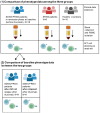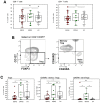Immunophenotypic Alterations in Adult Patients with Steroid-Dependent and Frequently Relapsing Nephrotic Syndrome
- PMID: 37175393
- PMCID: PMC10178237
- DOI: 10.3390/ijms24097687
Immunophenotypic Alterations in Adult Patients with Steroid-Dependent and Frequently Relapsing Nephrotic Syndrome
Abstract
Immune dysregulation plays a key role in the pathogenesis of steroid-dependent/frequently relapsing nephrotic syndrome (SDNS/FRNS). However, in contrast with evidence from the pediatric series, no major B- or T-cell alterations have been described for adults. In these patients, treatment with rituximab allows safe discontinuation of steroids, but long-term efficacy is variable, and some patients experience NS relapses after B cell reconstitution. In this study, we aimed to determine disease-associated changes in the B and T cell phenotype of adult patients with SDND/FRNS after steroid-induced remission. We also investigated whether any of these changes in immune cell subsets could discriminate between patients who developed NS relapses after steroid-sparing treatment with rituximab from those who did not. Lymphocyte subsets in SDNS/FRNS patients (n = 18) were compared to those from patients with steroid-resistant NS (SRNS, n = 7) and healthy volunteers (HV, n = 15). Before rituximab, SDND/FRNS patients showed increased frequencies of total and memory B cells, mainly with a CD38-negative phenotype. Within the T-cell compartment, significantly lower levels of FOXP3+ regulatory T cells (Tregs) were found, mostly due to a reduction in CD45RO+ memory Tregs compared to both SRNS and HV. The levels of CD45RO+ Tregs were significantly lower at baseline in patients who relapsed after rituximab (n = 9) compared to patients who did not (n = 9). In conclusion, patients with SDND/FRNS displayed expansion of memory B cells and reduced memory Tregs. Treg levels at baseline may help identify patients who will achieve sustained remission following rituximab infusion from those who will experience NS relapses.
Keywords: B cells; nephrotic syndrome; regulatory T cells; rituximab; steroid-dependent nephrotic syndrome; steroid-resistant nephrotic syndrome.
Conflict of interest statement
The authors declare no conflict of interest.
Figures





References
MeSH terms
Substances
LinkOut - more resources
Full Text Sources
Medical
Research Materials
Miscellaneous

